The 77th Royal Show.
Page 8

Page 9
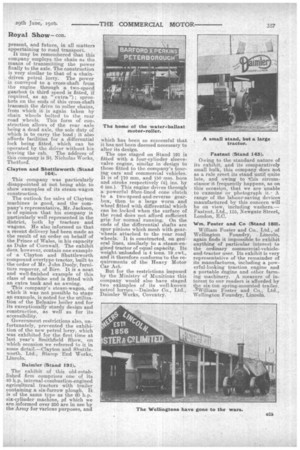
Page 10
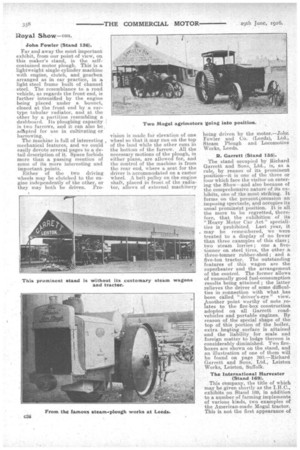
Page 11

Page 12
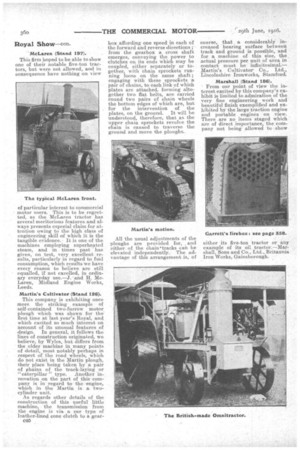
Page 13
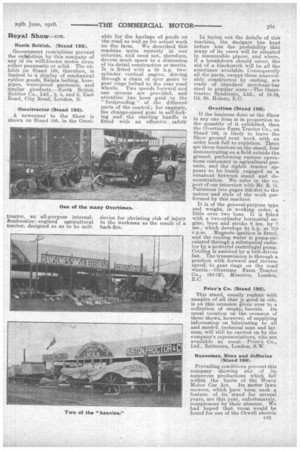
Page 14
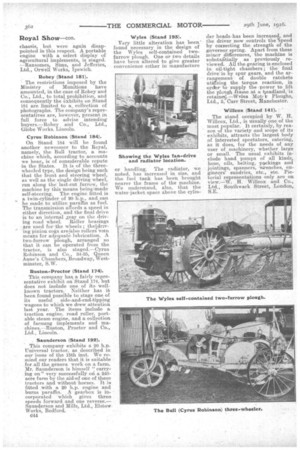
If you've noticed an error in this article please click here to report it so we can fix it.
Our Stand-to-Stand Report Necessarily Deals with the Agrimotor Exhibits as the Principal Sanctioned Feature.
, The 77th Royal Show is the second to be held during the course of the present war. Conflicting opinions were rife as to the desirability of holding it at all, and some rather outspoken comments have been made by one or two prominent members of the industry anent the need for concentrating on war-work only, to the exclusion of everything else. As to the necessity for prosecuting the war with the utmost rigour and vigour, there can be no two opinions. Whether it is advisable to cease altogether from any activity which does not directly bear on this object is rot so clear. Indirect bearings may be of national value. In effect, considering the Show as a whole, the general view seems to favour some attempt to "Keep the wheels of industry turning," as we gather that, on the whole, the Show is bigger than ever ; particularly is the increase in entries noticeable is the live-stock department. Concerning the Implement Section, however, during a war by machinery the need for concentration of particular efforts is obvious, and, in order to ensure equality of treatment, it was deemed desirable by the Ministry of Munitions to limit the exhibits to those• which are directly concerned with agricultural pursuits.
present,. and future, in all matters appertaining to road transport.
It may be remembered that this company employs the chain as the means of transmitting the power finally to the axle. The construction is very similar to that of a chain. driven petrol lorry. The power is conveyed to 2. cross-shaft from the engine through a two-speed gearbox (a third speed is fitted, if required, as an " extra ") ; sprockets on the ends of this cross-shaft transmit the drive to roller chains, from which it is again taken by ohain wheels bolted to the rear road wheels. This form of con, struction allows of the Tear axle being a dead axle, the sole duty of which is to carry the load ; it also affords facilities for a siifferential lock being fitted, which can be operated by the driver without his leaving the cab. The address of this company is St. Nicholas Works, Thetford.
Clayton and Shuttleworth (Stand 164).
This company was particularly disappointed at not being able to show examples of its steam-wagon construction.
The outlook for sales of Clayton machines is good,. and the company's representative, Mr. Jackson, is of opinion that his company is particularly well represented in the district, both by tractors and wagons. He also informed us that a recent delivery had been made as the result of an order on behalf of the Prince of Wales, in his capacity as Duke of Cornwall. The exhibit does, however, contain one example of a Clayton and Shuttleworth compound overtype tractor, built to the order of Mr. John Dooly, furniture remover, of Birr. It is a neat and well-finished example of this class of machine and is fitted with an extra tank and an awning.
This company's steam-wagon, of which it was not possible to stage an example, is noted for the utilization of the Beloaire boiler and for its exceptionally sturdy design and construction, as well as for its accessibility. Government restrictions also, unfortunately, prevented the exhibition of the new petrol lorry, which was exhibited for the first time at last year's Smithfield Show, on which occasion we referred to it in some detail.—Clayton and Shuttleworth. Ltd., Stamp End Works, Lincoln.
Daimler (Stand 191).
The exhibit of this old-estabIished firm comprises one of its 4G h. p. internal-combustion-engined agricultural tractors with trailer containing a six-furrow plough. It is of the same type as the 60 h.p. six-cylinder machine, pf which we are informed over 250 are in use by the Army for various purposes, and
which has been so successful that it has not been deemed necessary to alter its design.
The one staged on Stand 191 is fitted with a four-cylinder sleevevalve engine, similar in design to those fitted to the company's fouring cars and commercial vehicles.
i
It s of 110 ram. and 150 mm. bore and stroke respectively (44 ins. by 6 ins.). This engine drives through a powerful fibre-lined cone clutch to a two-speed-and-reverse gearbox, then to a large worm and -wheel fitted with differential which can be locked when the surface of the road does not afford sufficient grip for normal running. On the ends of the differential shafts are spur pinions which mesh with gear'wheels attached to the rear road wheels. It is constructed, on gen.eral lines, similarly to a steam-engined tractor of equal capacity. Its weight. unloaded is 4 tons. 19 cwt., and it therefore conforms to the requirements of the Heavy Motor Car Act.
But for the restrictions imposed by the Ministry of Munitions this company would also have staged two examples of its well-known petrol lorries.—Daimler Co., Ltd., Daimler Works, Coventry, Fastnut (Stand 145).
Owing to the standard nature of its exhibit, and its comparatively small bulk, this company does not as a rule erect its stand until quite late, and owing to 'this circumstance' it frequently happens, as on this occasion, that we are unable to examine or photograph it.. A range of the labour-saving devices manufactured by this concern will be on view, including washers.— Fastnut, Ltd., 115, Newgate Street, London, E.G.
Wm. Foster and Co (Stand 180).
William Foster and Co.. Ltd., of Wellington Foundry, Lincoln, again finds it impossible to exhibit anything of particular interest to the ordinary commercial-vehicleand-tractor user. Its exhibit is very representative of the remainder of its manufactures, including a powerful-looking traction engine and a portable engine and other farming machinery. A measure of interest to our readers is afforded by the six-ton spring-mounted trailer. Foster and Co., Ltd., Wellington Foundry, Lincoln. John Fowler (Stand 156).
Far and away the most important exhibit, from our point of view, on this maker's stand, is the selfcontained motor plough. This is a lightweight single-cylinder machine with engine, clutch, and gearbox arranged as in car practice, in a light steel frame built of channel steel. The resemblance to a road vehicle, as regards the front end, is further intensified by the engine being placed under a bonnet., closed at the front end by a cartype tubular radiator, and at the other by a partition resembling a dashboard. Its ploughing capacity ; is two furrows, and it can also be. adttpted for use in cultivating or harrowing. The Machine is full of interesting , mechanical features, and we could easily devote several pages to a detail description of it. Space forbids more than a passing mention of some of its more interesting and important points.
Either of the two driving wheels may be clutched to the engine independently of the other, or they may both be driven. Pro
vision is made for elevation of one wheel so that it may run on the top of the land while the other runs in the bottom of the furrow. All the necessary motions of the plough, in either plane, are allowed for, and the control of the machine is from. the rear end, where a seat for the driver is accommodated on a castor Wheel. A belt pulley on the engine shaft, placed in front of the radiator, allows of external machinery being driven by the motor.—John Fowler and Co. (Leeds), Ltd., Steam PlOugh and Locomotive Works, Leeds.
R. Garrett (Stand 155).
The stand occupied by Richard Garrett and Sons, Ltd., is, as a rule, by reason of its prominent position—it is one of the three or four which face the visitor on entering the Show—and also because of the comprehensive nature of its exhibits, one of the most striking. It forms on the presentoccasion an imposing spectacle, and occupies its usual prominent position. It is all the more to be regretted, therefore, that the exhibition of its "Heavy Motor Car Act" specialities is prohibited. Last year, it . may be remembered, we were treated to a display of no fewer than three examples of this class ; two steam lorries ; one a fivetuner on steel tires, the other a three-tonner rubber-shod ; and a five-ton. tractor. The outstanding features of this wagon are the superheater and the arrangement of the control. The former allows of unusually good fuel-consumption results being attained ; the latter relieves the driver of some difficulties in .connection with what has been called " driver's-eye " view, jinother point worthy of note relates to the fire-box construction adopted on all Garrett roadvehicles and portable engines. By reason of the special shape of the tip of this portion of the boiler, extra he4ting surface is attained and the liability, for scale and foreign matter to lodge thereon is considerably diminished. Two fireboxes are shown on the stand, and an illustration of one of them will be found on page 360.—Richard Garrett and Sons; Ltd., Leiston. Works, Leisthn, Suffolk.
The International Harvester (Stand 169).
This company, the title of which may be given shortly as the I.11.0., exhibits on Stand 169, in addition to a number of farming implements of various kinds, two examples of the American-made Mogul tractor. This is not the first appearance of this tractor at the Royal, as it was to be seen lastyear at Nottingham on the stand. of J. Mather and Co.
The two shown differ, one from another, both as regards power and also in the details of their transmission. The outstanding feature of both, however, is the slow speed of the engine, the normal revolutions per minute being only 400. At this speed the single-cylinder horizontal engine on the small tractor develops 16 h.p., and the horizontallyopposed twin-cylinder engine on the larger one gives 25 h.p. at the same r.p.in. On the 16 h.p. machine the ignition is by lowtension magneto, the valves are situated in the top of the combustion chamber, and a half-compression device is fitted to enable the engine, which is 8 _in. by 12 in. bore and stroke respectively, to be started by hand ; cooling is by 25 gallons of water in a tank. The transmission is by planetary gear, affording one speed in each direction, with final drive by chain.
On the larger machine a slidingwheel gearbox is provided, affording two speeds in a forward direction and one in reverse ; the transmission thence is by roller chain to a differential cross-shaft, the final drive being by a pair of side roller chains to chain wheels on the rear road wheels. Both engines run on paraffin after they have been warmed up by running on petrol for a few minutes. It is of interest to note that the Women's Legion, at the head of which is Lady London, derry, the secretary being Miss Brocklebank, of Wing Grange, Oakland, Rutlandshire, recently acquired one of these machines for demonstration purposes, to show how to diminish the amount of labour necessary on a farm.—The International Harvester Co., of Great Britain, Ltd., 80, Finsbury Pavement, London, E.C.
Ivel (Stand 190).
Wartime conditions almost .succeeded in preventing this company from staging an example of its tractor. Owing, however, to the kindness of Col. the Hon. W. Le Peer Trench, R.E. (Rtd.), C.V.O., J.P., St. Hubert's, Gerrards Cross, Bucks., who lent one of his machines for the purpose, a standard Ivel 24 h.p. tractor is on view. The Ivel is a three-wheeled machine, the front, or steering wheel, being centrally placed. Power is derived from a horizontally-opposed-twin-cylinder engine located amidships on the offside of the frame. This drives by silent chain to a countershaft and thence by roller chain to the differential on the rear axle. By means of an exhaustgas-heated vaporizer, it is made possible for paraffin to be used as the fuel for this machine. Dual ignition is provided, and a half
compression gear to give facility in starting. One speed in each direction is available, and the differential gear can be locked so as to afford additional traction when the going is bad. The tractor is shown attached to a three-furrow plough. --Ivel Agricultural Motors, Ltd., Biggleswade, Beds.
Mann (Stand 182).
Stand 182 contains an example of the company's compound agricultural tractor, an admirably desi ned machine, capable of doing e1±cient duty on the road as well as when engaged in purely fatming work. It shares with the tractor on Clayton and Shuttleworth's stand the honour of representing the interests of steam in regard to exhibits falling within the limits set by the Heavy Motor Car Order. It presents no new feature's, and only new readers will need to have
the principal points of its construction explained to them,
It is an overtype machine with compound horizontal engine carried on top of a locomotive-type boiler. An unusual feature of the latter— embodied in all Mann productions —is the side doors through which the fire is tended. One man can attend to coaling and wagon control.
The narrow track of the front wheels, and the central pivoting of the axle argue good steering lock, while the unusual suspension of the front axle on a pair of helical springs is worthy of note. All fittings for hauling various agricultural implements are included, as well as a belt pulley, which allows of stationary machinery being driven by the engine. It is shown with four-furrow plough attached.— Mann's Patent Steam Cart and Wagon Co., Ltd. Pepper Road Works, HunAet, McLaren (Stand 197).
This firm hoped to be able to show one of their notable five-ton tractors, but were not allowed, and in consequence have nothing on view of particular interest to commercial motor users. This is to be regretted, as the McLaren tractor has several meritorious features and always presents especial claim for attention owing to the high class of engineering skill of which it is the tangible evidence. It is one of the machines employing superheated steam, and in times past has given, on test, very excellent results, particularly in regard to fuel consumption, which results we have every reason to believe are still equalled, if not excelled, in ordinary everyday use.—J. and H. McLaren, Midland Engine Works, Leeds.
Martin's Cultivator (Stand 126). This company is exhibiting once more the striking example of self-contained two-furrow motor plough which was shown for the' first time at last year's Royal, and which excited so much interest on account of its unusual features of design. In general, it follows the lines of construction originated, we believe, by Wylcs, but differs from the older machine in many points of detail, most notably perhaps in respect of the road wheels, which do not exist in the Martin plough, their place being taken by a pair of phains of the track-laying .or "caterpillar " type. Another innovation on the part of this company is in regard to the engine, which in the Martin is a twocylinder unit.
As regards other details of the construction of this useful little machine, the transmission from the engine is via a car type of leather-lined cone clutch to a gear CLIO box affording one speed in each of the forward and reverse directions ; from the gearbox a cross shaft emerges, conveying the power to clutches on its ends which may be coupled, either separately or together, with chain sprockets running loose on the same shaft.; engaging with these sprockets a pair of chains, to each link of which plates are attached, forming altogether two flat belts, are carried round two pairs of chain wheels the bottom edges of which are, but for the intervention of the plates, on the ground. It will be understood, therefore, that as the upper chain sprockets revolve the chain is caused to traverse the ground and move the ploughs.
All the usual adjustments of the ploughs are provided for, , and either of the chain•tracks (. an be elevated independently. The advantage of this arrangement is, of
course, that a considerably increased bearing surface between track and ground is possible, and for a machine of this size, the actual pressure per unit of area in contact must be infinitesimal.— Martin's Cultivator Co., Ltd., Lincolnshire Ironworks, Stamford.
Marshall (Stand 186).
From our point of view the interest excited by this company's exhibit is limitecl to admiration of the very fine engineering work and beautiful finish exemplified and exhibited by the large traction engine and portable engines on view. There are no items staged which are of direct importance, the company not being allowed to show
either its five-ton tractor or any example of its oil tractor.—Marshall, Sons and Co., Ltd., Britannia Iron Works, Gainsborough. North British. (Stand 125).
Government restrictions prevent the exhibitiqn by this company of any of its well-known motor tires, either pneumatic or solid. The exhibit on Stand 125, therefore, is limited to a display of mechanical rubber goods, Balata belting, hosepipes, waterproof garments, and similar p'roducts.—North British Rubber Co. Ltd., 2, 4, and 6, East Road, City Road, London, N. • Omnitractor (Stand 185).
A newcomer to the Show is shown on Stand 185. in the Omni
tractor, an all-purpose internalkunbustion engined agricultural tractor, designed so as to be suit
able for the haulage of goods on the road as well as for actual work on the farm. We described this machine quite recently in our columns, and need not, therefore, devote much space to a discussion of its detail construction or merits. It is fitted with a 30 h.p. twocylinder vertical engine, driving through a chain of spur gears to gear rings bolted to the rear road wheels. Two speeds forward and one reverse are provided, and attention has been paid to the " foolproofing " of the different parts of the control; for example, the ehange-speed gear is sell-locking and the starting handle is fitted with an -effective safety device for obviating risk of injury to the .workman as the result of a back-fire.
In laying out the details of this machine, the designer has kept before him the probability that many of its users • will be situated in inaccessible places, and where, if a breakdown should occur, the aid of a blacksmith will be all the assistance available. Consequently all the parts, except those unavoidably. constructed by casting, are made of standard merchant-bar steel in popular sizes.—The Omni-, tractor Syndicate, Ltd., of 18-19, Gt. St. Helens, E.C.
Overtime (Stand 196).
If the business done at the Show in any one item is in proportion to the quantity of it exhibited, then the Overtime Farm Tractor Co., on Stand 196, is likely to leave the Show ground next week with an order book full to repletion. There are three tractors on the stand, four demonstrating on a field outside the ground, performing various operations customary in agricultural pursuits, and the eighth tractor appears to be busily , engaged as a, runabout between stand and demonstration. We refer in the report of our interview with Mr. R. G. Patterson (see pages 352-3.54) to the nature and style of the work performed by this machine.
It is of the general-purpose type and weighs, in working order, a little over two tons. It is fitted with a two-cylinder horizontal engine, bore and stroke 6 ins. by 7 ins., which develops 24 h.p. at 760 r.p.m. Magneto ignition is fitted, and the cooling water is pump-circulated through a substantial radiator by a powerful centrifugal pump. Cooling is assisted by a belt-driven fan. The transmission is through a gearbox with forward and reverse speed, to gear rings on the road wheels.—Overtime Farm Tractor Co., 124-127, Minories, London, E.C.
Price's Co. (Stand 195).
This stand, usually replete with samples of all that is good in oils, is on this occasion given over to a collection of empty: barrels. Its usual vocation on the occasion of these shows, however, of supplying information on lubricating to all and sundry, technical man and layman, will still be carried on by the company's representatives, who are available as ustial.—Price's Co., Ltd., Battersea, London, S.W.
Ransomer!, Sims and Jefferies (Stand 166).
Prevailing conditions prevent this company showing any of its numerous productions which fall within the limits of the Heavy Motor Car Act. Its motor lawn mowers, which have been such a feature of its stand for several years, are this year, unfortunately, conspicuous by their absence. We had hoped that room would be found for one of the Orwell electric chassis, but were again disappointed in this respect. A portable engine with a select display of agricultural implements, is staged. —Ransomes, Sims, and Jefferies, Ltd., Orwell Works, Ipswich.
Robey (Stand 181).
The restrictions imposed by the Ministry of Munitions have amounted, in the case of Robey and Co., Ltd., to total prohibition, and consequently the exhibits on Stand 181 are limited to a, collection of photographs. The company's representatives are, however, present in full force to advise intending buyers.—Robey and Co., Ltd., Globe Works, Lincoln.
Cyrus. Robinson (Stand 184).
On Stand 184 will be found another newcomer to the Royal, namely, the Bull tractor, a machine which, according to accounts we hear,, is of considerable repute in the States. It is of the three-wheeled type, the design being such that the front and steering wheel, as well as the single driving wheel, run along the last-cut furrow, the machine by this means being4nade self-steering. The engine fitted is a twin-cylinder of 20, h.p., andcan be made to utilize paraffin as fuel. The transmission affords a speed in either direction, and the final drive is to an internal gear on the driving road wheel. Roller bearings are used for-the wheels ; theldriving pinion cogs areiitlso rollers vrtn means for adequate lubrication. A two-furrow plough, arranged' so that it can be operated from the tractor, is also staged.—Cyrus Robinson and Co., 34-35, Queen Anne's Chambers, Broadway, Westminster, S.W.
Ruston-Proctor (Stand 174).
This company has a fairly representative exhibit on Stand 174, but does not include •one of its wellknown tractors. Neither has it been found possible to stage one of its useful side-and-end-tipping wagons to which we drew attention last year. The items include a traction engine, road roller, portable steam engine, and a collection of farming implements and machines.—Ruston, Procter and Co., Ltd. Lincoln.
Saunderson (Stand 192).
This company exhibits a 20 h.p. Universal tractor, as described in our issue of the 15th inst. We TOmind our readers that it is suitable for all the genera work on a farm. Mr. Saunderson is himself `: carry-. ing on "very successfully on a 240acre farm by the aid.of Oile of these tractore and without 'horses. It is fitted with a 20 h.p. engine and burns paraffin. A gearbox is incorporated which gives three speeds forward and one reverse.Saunderson and Mills, Ltd., Elstow Works, Bedford.
c44 Wyles (Stand 193). • Very little alteration has been' found necessary in the design of the Wyles sell-contained twofurrow plough. One or two details have been altered to give greater convenience either in. manufacture
or handling. The radiator, we noted, has increased in size, and the fuel tank has been brought nearer the frame of the machine. We understand, also, that the water-jacket space above the cylin
der heads. has been increased, and the driver now .controls the -speed by correcting the strength of the governor spring. Apart from these minor _differences, the machine is substantially as previously reviewed. All the gearing is.enclosed in oil-tight chambers ; the final drive-is by spur gears, and the arrangement of double ratchets n6E-zing the torque reaction, in ordhr to supply the power to lift the plough flame at a Ileadland, is retaine.e.„ —Wvles Met! c Ploughs, Ltd., 5, Carr Street, Manchester.
Willcox (Stand 141). • The stand occupied by W. H. Willcox, Ltd., is usually one of the most popular. It certainly, by reason of the variety and scope of its exhibits, attracts the largest body of interested spectators, catering, as it dbes, for the needs of any user of machinery, whether large or small. The usual exhibits include hand pumps of all kinds, hose, oils, belting, packings and jointings, spanners, -Rzenches, engineers' sundries, etc., etc. Pictorial representations only are on view.-W. H. Willcox and Co., Ltd., Southwark Street, London, S.E.






























